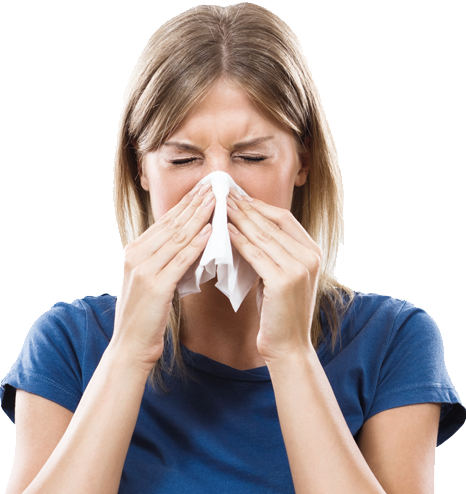How should allergies to dust mites be diagnosed?
The most important test to confirm or exclude allergy is a skin prick test performed by an allergist. Purified extracts of inhaled allergens are used during the test. The examples include: allergens of house dust mites, animal dander, fungi and pollen. Medical history, which allows to determine the circumstances and exacerbation of the allergic symptoms, should become a hint to perform the test. Although sensitisation to household dust occurs year-round, its exacerbation is a diagnostic premise. It manifests in the morning and at night, most often in autumn and winter (when apartments are heated). Furthermore, well-being may worsen during cleaning, emptying the vacuum cleaner or staying in the attic, basement or in an old house. However, the condition improves while staying away from home. The most common symptoms include runny nose, sore throat, dry paroxysmal cough, along with skin lesions.
Roll up UnrollDisturbing symptoms
Symptoms develop as a result of inhalation of allergens by a sensitised person. Watery secretion, nasal obstruction (experienced as a sense of blocked nose), itching and sneezing appear within a few minutes since the contact with allergen. There is also a risk of acute and chronic sinusitis. Exacerbation of symptoms depends on the individual characteristics of the allergy sufferer as well as the concentration of allergens at home.
Severe cases of chronic allergic rhinitis may lead to sleep disorders and reduced daily physical activity and cause difficulties in concentrating while learning and at work.
Roll up Unroll

Why prevention is so important
There is a close relationship between presence of allergens in household dust and development of sensitisation and bronchial asthma. Exposure to high concentration of household dust mite allergens leads to an increase in bronchial hyperreactivity and it is associated with more severe course of allergy, greater use of drugs and even the need of hospitalisation during exacerbations of the disease. It was revealed that there is a linear relationship
between the risk of developing asthma and the concentration of the primary allergen Dermatophagoides pteronyssinus (Der p1) in household dust - the risk is doubled every doubling of the concentration of Der p1 in a concentration range of 0.7 to 50 mg per 1 gram of dust.
An important part of prevention and treatment of allergic diseases, including asthma, is to eliminate allergens from the environment. Effective prevention efforts may alleviate the symptoms and reduce the risk of exacerbations. It was also shown that elimination of allergens may protect people with atopic features against the development of allergic disease, relieves of the symptoms, lowers the use of anti-allergic drugs, and above all, improves the quality of life of sensitized people.
How to alleviate symptoms of allergy?
In order to limit their contact with allergens, persons allergic to dust get rid of carpets, curtains and other items that accumulate dust from their homes. Traditional, even daily cleaning does not protect allergy sufferers from contact with dust and what is more, dust particles start to hover in the air during cleaning which only worsen the condition.
As part of prevention, physicians often order to avoid contact with allergens. Effective preventive measures, which were undertaken early, may help to decrease the incidence of allergy and if symptoms occur, the disease may take mild form.
Reducing the concentration of allergens in households to the safe level may improve well-being and significantly enhance life quality of people allergic to household dust.

How to distinguish an allergy from a cold
A year-round presence of sensitisation symptoms due to constant exposure to household allergens is a typical sign of allergic rhinitis. In order to distinguish this type of allergy from a common cold caused by viral infection, the attentions should be focused on duration of the symptoms. Viral rhinitis usually lasts for 10 days.